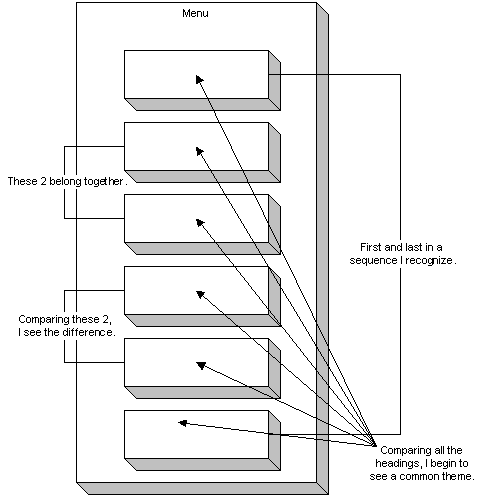The Scottish philosopher
Sir William Hamilton (1788-1856) wrote: "If
you throw a handful of marbles on the
floor, you will find it difficult to view
at once more than six, or seven at most,
without confusion." This was confirmed by
the English economist William Stanley
Jevons (1835-82) by throwing beans into a
box and estimating their number. He found
that he never made a mistake with three or
four, was sometimes wrong when there were
five, was right about half the time with
ten beans, and was usually wrong with
fifteen. These experiments are cited by the
American psychologist George Miller, the
author of the famous paper, "The Magic
Number Seven, Plus or Minus Two" (1956).
Miller found that more items can be
remembered when they are coded, or
"chunked."
—Gregory (1987)
Another reason to group
operations is to break up a menu so it’s
easier to read. —Apple (1987)
Use meaningful
groupings of menu choices. …Use
meaningful ordering of menu choices.
—Hix & Hartson (1993)
Don’t let menus just run
on with a dozen submenu items without
offering the eye and the brain some
grouping clues. —Minasi (1994)
Menus can also help aid
long-term memory retrieval. Menu interfaces
should be designed to present items in
logical groupings rather than simply in
alphabetical or random order. —Mandel (1994)
Long menu lists can
usually be grouped into smaller logical
groups to chunk items for users to
remember more easily. Menu interfaces
should be designed to present items in
logical groupings rather than simply in
alphabetical or random order. The screen
layout and organization of menus allow
users to assign meanings to the groupings
and make both the menus and the individual
choices more memorable. —Mandel (1997)
The Grouping choices into
functional units will reduce mental
effort and help people quickly
interpret your whole page. For example,
with the appropriate layout, people will
quickly interpret a list of 12 adjectives
(such as comedy, drama, Western, and so on)
as a single set of movie genres. —Keeker
(1997)
It must be possible
somehow to read the structure to
find good paths; the structure must be
view navigable. —Furnas (1997)
Help viewers understand
the nature of the relationships you use,
e.g., use hierarchies or heterarchies of
information that embody clear, logical
structures. Because viewers become easily
bored, disinterested, or irritated with
lists of unordered items or links, and have
difficulty finding specific information in
random lists, create useful
organizational structures to support
scanning and locating information.
—Ameritech (1998)
Humans are driven to seek
out structure and pattern.
By implication, readers will learn the
"flow" of your site—but only if you let
them. —Sullivan (1998)
Situational awareness
..[is the] continuous extraction of
environmental information, integration of
this information with previous knowledge to
form a coherent mental picture, and the use
of that picture in directing further
perception and anticipating future events.
—Whitaker (1998)
Make sure the structure
itself stays clear wherever you are within
the pyramid or tree. —Abeleto (1999)
To be useful to an
Internet audience, each site must deliver
entertainment or knowledge,
or improve the way its audience
accomplishes some important task
(such as purchase ticks or get fit). … Tell
potential audience members how your site
is relevant to them. Identify related
topics or tasks that are important to your
target market. —Microsoft (2000)
"Non-linear" media
require strong structures and
content narratives. —Lynch (2000)
Group information to help
readers create hierarchical frameworks
for storing incoming information in
long-term memory.
… We know that readers
organize information in long-term memory in
a hierarchical fashion (McKoon 1977).
Chunking or grouping information items
facilitates the reader in building these
LTM frameworks and decreases attentional
demands because readers can perceive the
text structure more easily.—Spyridakis (2000)
Design the interface to
readily reveal the underlying
information structure. … That is, the
interface should suggest the Web site’s
underlying information structure. The
information structure, in turn, helps users
better understand the relationships
among the ideas that appear on the various
pages of the Web site.—Farkas and Farkas
(2000)
See bibliography:
Abeleto (1999),
Ameritech (1998),
Apple (1987),
Cooper
(1995, 1999),
Farkas and Farkas
(2000),
Furnas (1997),
Golledge
(1999a), Gregory (1987),
Hix & Hartson (1993),
Keeker
(1997), Krug (2000),
Larson & Czerwinski (1998),
Lynch
(1960), Lynch (2000),
MacEachren (1992),
Mandel
(1994, 1997),
McKoon
(1977), Microsoft (2000),
Miller
(1956), Minasi (1994),
Norman
(1991), Price
(1999),
Spyridakis (2000),
Sullivan (1998),
Thinus-Blanc
and Gaunet (1999),
Whitaker (1998)
Joseph Paxton, Designer of the
Crystal Palace



